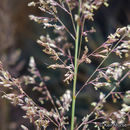Comprehensive Description
(
Inglês
)
fornecido por North American Flora
Muhlenbergia emersleyi Vasey, Contr. U. S. Nat. Herb. 3 : 66. 1892.
Muhlenbergia Vaseyana Scribn. Rep. Mo. Rot. Gard. 10: 52. 1899. (Based on M. distichophylla as described by Vasey, in Rothr. Bot. Wheeler's Surv. 283. 1878. Type from Arizona, Rolhrock282).
Epicampes Emersleyi Hitchc. Bull. U. S. Dep. Agr. 772: 144. 1920. (Based on Muhlenbergia Emersleyi Vasey.)
Epicampes subpatens Hitchc. Bull. U. S. Dep. Agr. 772: 144. 1920. (Type from Guadalupe Mountains, New Mexico. Hitchcock 13541. Spikelets awnless.)
Perennial; culms stiffly erect in small bunches, glabrous, 50-150 cm. tall, with 1 or 2 nodes below the middle; sheaths scaberulous, the lower, especially of the innovations, compressedkeeled; ligule softly membranaceous, 1-2 cm. long; blades flat or folded, scabrous, elongate, 1-4 mm. wide; panicle narrow but rather loose, erect or nodding, mostly 20-40 cm. long, the branches ascending, more or less fascicled or whorled, naked below, 5—10 cm. long; spikelets 2.5-3 mm. (rarely less) long, often purplish; glumes thin, equal, acutish, scabrous; lemma mostly a little shorter than the glumes, narrowed and scabrous above, villous below, with a delicate flexuous awn 1-2 cm. long or sometimes awnless.
Type locality: Southern Arizona (Emersley).
Distribution: Rocky woods and ravines, Texas to Arizona, and southward to Panama.
- citação bibliográfica
- Albert Spear Hitchcock. 1935. (POALES); POACEAE (pars). North American flora. vol 17(6). New York Botanical Garden, New York, NY
Comprehensive Description
(
Inglês
)
fornecido por North American Flora
Muhlenbergia distans Swallen, sp. nov
Perennial, rather slender; culms erect, glabrous, puberulent below the nodes, scabrous beloiv the panicle, 1-2-noded near the base, 50-100 cm. tall; sheaths compressed-keeled, scaberulous; ligule delicate, enclosed in the folded base of blade, 4-8 mm. long or longer; blades mostly basal, elongate, folded at base, flat above, or those of the innovations folded throughout, rather lax, rather finely scabrous on the margins, 1-4 mm. wide, the apex slender and acuminate but not narrowed to a long fine point; panicle narrow, plumbeous, slightly nodding, rather lax, mostly 20-30 cm. long, the axis scabrous, the branches appressed or ascending, slender, distant below, scabrous, naked on the lower half, rather loosely flowered above, some of the lower as much as 6-8 cm. long; glumes equal, narrowed to a rather obtuse point, scaberulous, 3-3.5 mm. long; lemma about as long as the glumes or slightly longer, acute, scarcely bifid, moderately villous all over, the awn somewhat curved or flexuous, mostly 2-4 mm. long, sometimes longer.
Perennis; culmi erecti, infra nodos puberuli, infra paniculam scabri, 50-100 cm. alti; vaginae compresso-carinatae scaberulae; laminae elongatae, in parte inferiore conduplicatae, in parte superiore planae, 1-4 mm. latae; panicula angusta plumbea 20-30 cm. longa, ramis appressis vel ascendentibus, inferioribus distantibus, infra nudis usque ad 6-8 cm. longis; ghimae scaberulae 3-3.5 mm. longae; lemma glumas aequans villosura, arista 2-4 mm. longa.
Type collected on drv hills, alt. ISOO m.. Las Sedas. Oaxaca, September 15. 1894, Pringle 5575 (U. S. Nat. Herb. no. 746297).
- citação bibliográfica
- Albert Spear Hitchcock. 1935. (POALES); POACEAE (pars). North American flora. vol 17(6). New York Botanical Garden, New York, NY
Physical Description
(
Inglês
)
fornecido por USDA PLANTS text
Perennials, Terrestrial, not aquatic, Stems nodes swollen or brittle, Stems erect or ascending, Stems caespitose, tufted, or clustered, Stems terete, round in cross section, or polygonal, Stems branching above base or distally at nodes, Stem internodes hollow, Stems with inflorescence 1-2 m tall, Stems, culms, or scapes exceeding basal leaves, Leaves mostly cauline, Leaves conspicuously 2-ranked, distichous, Leaves sheathing at base, Leaf sheath mostly open, or loose, Leaf sheath smooth, glabrous, Leaf sheath or blade keeled, Leaf sheath and blade differentiated, Leaf blades linear, Leaf blades 2-10 mm wide, Leaf blades mostly flat, Leaf blade margins folded, involute, or conduplicate, Leaf blades mostly glabrous, Leaf blades scabrous, roughened, or wrinkled, Ligule present, Ligule an unfringed eciliate membrane, Inflorescence terminal, Inflorescence a contracted panicle, narrowly pan iculate, branches appressed or ascending, Inflorescence solitary, with 1 spike, fascicle, glomerule, head, or cluster per stem or culm, Inflorescence branches more than 10 to numerous, Flowers bisexual, Spikelets pedicellate, Spikelets laterally compressed, Spikelet less than 3 mm wide, Spikelets with 1 fertile floret, Spikelets solitary at rachis nodes, Spikelets all alike and fertille, Spikelets bisexual, Spikelets disarticulating above the glumes, glumes persistent, Spikelets disarticulating beneath or between the florets, Rachilla or pedicel glabrous, Glumes present, empty bracts, Glumes 2 clearly present, Glumes equal or subequal, Glumes shorter than adjacent lemma, Glumes 1 nerved, Lemmas thin, chartaceous, hyaline, cartilaginous, or membranous, Lemma similar in texture to glumes, Lemma 3 nerved, Lemma body or surface hairy, Lemma apex dentate, 2-fid, Lemma distinctly awned, more than 2-3 mm, Lemma with 1 awn, Lemma awn 1-2 cm long, Lemma awn subapical or dorsal, Lemma awns straight or curved to base, Lemma margins thin, lying flat, Lemma straight, Callus or base of lemma evidently hairy, Callus hairs shorter than lemma, Palea present, well developed, Palea membranous, hyaline, Palea about equal to lemma, Palea 2 nerved or 2 keeled, Stamens 3, Styles 2-fid, deeply 2-branched, Stigmas 2, Fruit - caryopsis, Caryopsis ellipsoid, longitudinally grooved, hilum long-linear.
Muhlenbergia emersleyi: Brief Summary
(
Espanhol; Castelhano
)
fornecido por wikipedia ES
Muhlenbergia emersleyi es una especie de planta herbácea perteneciente a la familia de las poáceas.
- licença
- cc-by-sa-3.0
- direitos autorais
- Autores y editores de Wikipedia
Muhlenbergia emersleyi: Brief Summary
(
Vietnamita
)
fornecido por wikipedia VI
Muhlenbergia emersleyi là một loài thực vật có hoa trong họ Hòa thảo. Loài này được Vasey mô tả khoa học đầu tiên năm 1892.
- licença
- cc-by-sa-3.0
- direitos autorais
- Wikipedia tác giả và biên tập viên

